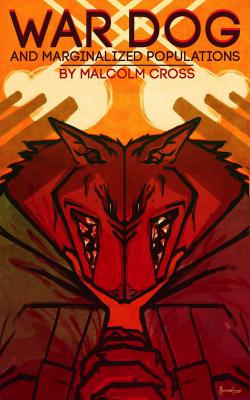War Dog & Marginalized Populations
Jane, Jill and Jasie
(Two ebooks, $2.99 each)
Stories by Malcolm Cross
Cover Art by Meesh
Bad Dog Books, July 2013
Anthropomorphic animal characters have been around as long as stories themselves, yet how to justify them—especially if they’re assumed, implicitly or explicitly, to be attractive to humans—has long been a preoccupation in furry fandom. Are they aliens? Uplifted animals? Genetic crossbreeds? Magical constructs? Do we even need to justify them, or is just showing that they’re distinct races—not merely “humans in animal costumes,” as the charge goes—enough?

Malcolm Cross’s two recent ebook-only collections, War Dog & Marginalized Populations and Jane, Jill and Jasie, seem at first glance to positively revel in worn cliché. Genetically engineered animal people created to be soldiers and sex toys. Referring to them as “furries” within the text (and without irony). It’s all the more remarkable, therefore, not only how accomplished these stories are, but how thought-provoking they turn out to be.
The first of the two contains the two stories in its title, while the second contains three stories: “Dick and Jane,” “Jill’s Forty-Ninth” and “Jasie’s New Start.” All of the stories are written in a third person tightly bound to the given viewpoint character’s voice, a style readers of Cross’s recent Ursa Major winner, “Dangerous Jade,” will be familiar with. Like “Jade,” these stories are set in the country of San Iadras, a milieu that seems to possess Dubai’s wealth and Monte Carlo’s licentiousness. The history of the furries is never spelled out, but we can infer the different species were uplifted for different purposes: dogs for the military, rabbits as personal care assistants, and thylacines—a doglike carnivorous marsupial, now extinct—as adult companions. At some point before the stories’ timeline, though, their legal status in San Iadras changed, and they’re now free citizens.
And yes, we’ve seen that rough premise before, in furry fandom at least back to Dave Bryant’s and Ken Pick’s “Wormholes” setting and in sci-fi at least back to Cordwainer Smith‘s “The Ballad of Lost C’Mell.” But we’ve most often seen these worlds through humans coming to understand that furries are people too. Cross’s viewpoint is that of the furry: designed for purposes they’re no longer subject to, adopted out to human families often ill-equipped to deal with them and now making their adult lives in a society that, while accepting, doesn’t quite understand them.
“War Dog” is the story of one of those adoptions, with a school-age child; while it’s a story of trying to fit in—nearly all stories set in school are—being a human-sized dog among human children is the least of Eschowitz’s challenges. “Marginalized Populations” follows soldier dogs a few years later, trying to find private military work. While “War Dog” is the longest of the five stories and in some ways the most complete, the stories of the thylacines—even with sex scenes which might best be called blunt rather than merely explicit—mine surprisingly emotional territory.

These stories are not morality plays of good furries and bad humans; the characters are all complex, even the ones who seem straightforward. (Often especially those ones.) There are several heartbreaking moments—often unexpectedly so, as when Jane (in “Dick and Jane”) breaks down after discovering the relationship she’s in isn’t at all what she thinks it is. Yet none of these stories are tragedies. “Jasie’s New Start” has an unreservedly happy ending. All five pieces arguably end with their protagonists in better places than where they started.
Yet the question of just what a happy ending is looms large in “War Dog” and “Marginalized Populations” and never stays far away in the thylacine stories. Each piece here explores the age-old nature versus nurture question—not to argue for one side or the other as much as to simply make us think about it. After reading these, one can’t help but acutely feel the absence of this in most other stories–and there’s a lot of them in this fandom–built on the trope of genetic engineering. You may be against war in general and very much against the notion of designing intelligent beings to be soldiers, yet freeing them doesn’t stop them from being soldiers. Jane, Jill and Jasie–and their one hundred and sixty-six other cloned sisters, all named “J” and all virtually impossible to tell apart even for one another—are engineered not for fighting but to be party girls. The reader understands more of what drives Eschowitz than he does himself very shortly into his story; the “J” sisters are likewise affected more by their programming than they—at least most of them–understand. It’s not a matter of what they want; it’s a matter of what they must. For the dogs, their design is their dilemma; for the thylacines, their design frequently creates their dilemmas. Or perhaps it’s the other way around.
If I have any nitpicks—and frankly this is straining a little—it’s with how similar to our current world San Iadras seems. The train Jasie takes in her story is a maglev and Eschowitz’s story features “smartpaper,” but for the most part the pieces could take place today if we just happened to have genetically engineered animal-people about. This makes the stories more accessible than they might be if the setting were more alien, but it’s hard not to wonder if everyday life in San Iadras—especially in the echelons of high society the thylacines inhabit—shouldn’t feature a few more futuristic touches than we see.
In the works I’ve read by him, Cross shows an extremely distinctive voice, staying so much in the viewpoint character’s head that it borders on stream of consciousness. This can be unsettling or even off-putting; an uncareful reader might dismiss the thylacines as bobbleheads, and the dogs are just as focused in their own ways. But there are few genuine stylists among furry authors and even fewer this good. These five stories are quick but hardly ephemeral, and they’re more than worth their asking price.
